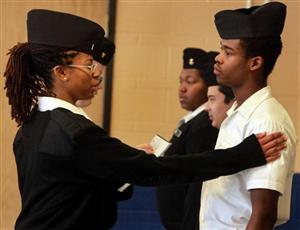Akirah Honeywood, (left), a junior at Cleveland Junior Naval Academy ROTC and a platoon commander, points out the lack of proper insignias on cadet Daryll Williams during drill practice inspection in Naval Science class on Thursday, Jan. 25, 2013. Honeywood plans to enter the National Guard after graduating. Photo by Christian Gooden, cgooden@post-dispatch.com
January 26, 2013 1:15 am •
James West leaned forward in his chair Friday as he considered the Pentagon’s decision to lift the ban on women serving in front line combat.
He and his classmates at Cleveland Junior Naval Academy debated whether women in combat roles could introduce problems that otherwise wouldn’t exist in all-male units. Or whether women are physically suited. Or whether lifting the ban is merely a formality, because women fighting in Iraq and Afghanistan have frequently found themselves in the line of fire.
West, who plans to enlist in the Army after graduation, said simply, “If a woman has the qualifications, she should be able to do it.”
Eight other students shared that opinion in the Contemporary Issues class.
Several plan to enlist in the military after graduation. They will be among the first generation of military personnel to experience the full impact of the new policy on women in combat, which will roll out over several years.
The announcement from Defense Secretary Leon Panetta this past week in effect overturns a 1994 Pentagon rule prohibiting women from combat roles in U.S. armed forces.
“Is this earth shattering? Is this life changing?” teacher Debbie Schmidt asked her students.
“To some people, yeah,” one student said.
It’s a perennial topic among those with their sights on a military career — particularly young women who want to be in infantry.
For generations, women formally have been prohibited from combat posts in the Army, but routinely served as medics, pilots and drivers, placing them shoulder to shoulder with men serving in combat jobs.
Increasingly, all branches of the military are opening opportunities to women.
In 1993, the Navy allowed women on ships. Then in 2010, the Navy lifted the ban on women serving on submarines.
That announcement, like the one this week, broadened the horizons of girls at Cleveland Junior Naval Academy, 4939 Kemper Avenue, a full-fledged military magnet school in the St. Louis public school system.
“It gave me other possibilities in the Navy other than being a nurse or a cook,” said Torshawna Griffin, a senior at Cleveland. Now her goal is to become a high-ranking naval officer on a submarine.
About 40 percent of the 285 students at Cleveland are girls. About 10 percent of Cleveland graduates each year enter the military. The program makes no distinctions on gender. All students, male and female, participate in the same drills and receive the same grounding in military preparations.
The high school is distinct from the ROTC officer training program at colleges and universities. That program requires eight years of military service.
Locally, the program has about 110 members at nine area universities, said Lt. Col. Jim Craig, commanding officer of St. Louis area Army ROTC. About one-third of the cadets are women.
“You hate to look at your soldiers or cadets and say, ‘I know you’re talented, but that’s closed,’” said Craig, who is supportive of opening more of the military to women. “Now there’s nowhere their talents won’t take them.”
Nationwide, women comprise about 15 percent, or nearly 202,400, of the U.S. military’s 1.4 million active personnel, according to the Department of Defense. More than 280,000 women have deployed in support of operations in Iraq and Afghanistan.
Some positions may remain closed to women. Services have until 2016 to make the case that they should not allow women to perform certain roles.
At Cleveland, the logistics and details of this week’s announcement had particular resonance. And teachers such as James Francis, who joined Schmidt’s class as part of the discussion, used it as a springboard for debate.
For example, he brought up the challenges of showering and other personal tasks in a mixed-gender environment.
“Remember you have no privacy whatsoever,” said Francis, a world history instructor.
There’s the question of hygiene on the battlefield. And there’s the issue of stamina, he added. Could a woman carry a 200-pound wounded soldier to safety? he asked.
“If you cannot pick up that 200-pound man, you leave him on the battlefield and he could die,” Francis said.
Tracy Tran, a senior, picked up on that point. Scientifically, she said, there are limitations on how strong women can be.
But not all men can carry 200 pounds, Torshawna Griffin said.
That kind of comment triggered broader conversation about whether this week’s announcement would lead to lower physical standards for women.
The class ended before the conversation had run its course. And as the students left, it was clear the debate at the school was just beginning.


